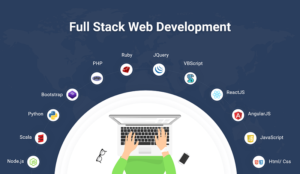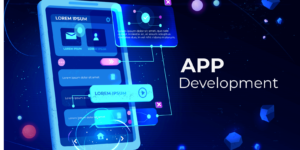Introduction
Front-end development is the backbone of user interaction with websites and applications. As a front-end developer, you’re responsible for crafting visually appealing, responsive, and user-friendly interfaces that captivate and engage users. If you aspire to enter this exciting field, this guide will provide you with a detailed roadmap to becoming a skilled front-end developer.
What is Front-End Development?
Front-end development focuses on the visible parts of a website or application that users interact with directly. It involves a combination of:
- Design Implementation: Translating UI/UX designs into functional code.
- Interactivity: Using JavaScript to make websites dynamic and responsive.
- Performance Optimization: Ensuring websites load quickly and function seamlessly across devices.
Examples of Front-End Development in Action:
- Responsive Web Design: Websites that adapt seamlessly to mobile, tablet, and desktop screens.
- Interactive Features: Dropdown menus, sliders, modals, and real-time updates on web pages.
- Accessible Interfaces: Websites that are easy to navigate for all users, including those with disabilities.
Why Choose Front-End Development?
- Creative Freedom: Combine coding skills with design to build visually stunning websites.
- High Demand: Businesses are always in need of developers who can create engaging user experiences.
- Diverse Opportunities: Work on websites, mobile applications, e-commerce platforms, and more.
Industry Insights:
- The demand for front-end developers has seen a steady rise due to the rapid growth of web-based services.
- Average salaries range between $70,000 and $120,000 annually depending on experience and location.
Key Skills for Front-End Developers
To excel in front-end development, you need to master a combination of technical skills and best practices.
Core Technologies:
- HTML (HyperText Markup Language)
- Forms the structure of a web page.
- Example: Creating headers, paragraphs, images, and links.
- CSS (Cascading Style Sheets)
- Adds styling to web pages.
- Key Concepts: Flexbox, Grid, Animations, Media Queries.
- JavaScript
- Adds interactivity and functionality.
- Examples: Creating dynamic content, sliders, and form validation.
Frameworks and Libraries:
- CSS Frameworks: Bootstrap, Tailwind CSS.
- JavaScript Libraries: React, Vue.js, Angular.
Version Control:
- Learn Git and GitHub to track changes and collaborate on projects.
Responsive Design:
- Build websites that work flawlessly on all devices.
Web Performance Optimization:
- Techniques like lazy loading, minimizing HTTP requests, and using Content Delivery Networks (CDNs).
How to Start Your Journey as a Front-End Developer?
1. Learn the Basics:
- Start with HTML and CSS to create static web pages.
- Move on to JavaScript for interactivity.
2. Take Online Courses:
- FreeCodeCamp – Comprehensive lessons on HTML, CSS, and JavaScript.
- The Odin Project – Free, structured front-end and full-stack development curriculum.
- Modern JavaScript on Udemy – A deep dive into JavaScript.
3. Build Small Projects:
- Create a portfolio website for yourself.
- Develop a to-do list app using vanilla JavaScript.
- Clone popular websites to practice HTML, CSS, and JavaScript.
4. Learn Frameworks:
- Master Bootstrap or Tailwind CSS for faster styling.
- Learn React.js or Vue.js to build dynamic, component-based applications.
5. Practice Version Control:
- Use Git for project versioning.
- Create repositories on GitHub to showcase your projects.
6. Stay Updated:
- Follow front-end trends and best practices through blogs, forums, and YouTube channels like Traversy Media.
A 6-Month Roadmap to Front-End Development
Months 1–2: Foundations
- Learn HTML5 and CSS3.
- Understand JavaScript fundamentals (variables, loops, functions).
Months 3–4: Intermediate Skills
- Practice responsive design with CSS Grid and Flexbox.
- Explore JavaScript DOM manipulation and events.
Months 5–6: Advanced Skills and Projects
- Learn a JavaScript framework (e.g., React.js).
- Build a portfolio project like an e-commerce website or a personal blog.
Recommended Resources
Books:
- “Eloquent JavaScript” by Marijn Haverbeke: A deep dive into JavaScript.
- “HTML and CSS: Design and Build Websites” by Jon Duckett: A beginner-friendly guide to front-end basics.
YouTube Channels:
- Traversy Media: Tutorials on front-end technologies.
- The Net Ninja: JavaScript, React, and CSS tutorials.
Communities:
- Join forums like Reddit’s r/webdev and participate in discussions.
- Engage with the community on platforms like Hashnode and Dev.to.
Tools Every Front-End Developer Should Know
- Code Editors: VS Code, Sublime Text.
- CSS Preprocessors: Sass, LESS.
- Browser DevTools: For debugging and testing your code.
- CodePen: For quick prototyping and sharing your work.
Conclusion
Front-end development is a dynamic and rewarding career path that blends creativity with technical expertise. By mastering the right skills, building real-world projects, and staying updated with industry trends, you can become a successful front-end developer and create impactful user experiences.
Are you ready to begin? Share your thoughts or ask questions in the comments below, and let’s embark on this journey together!




